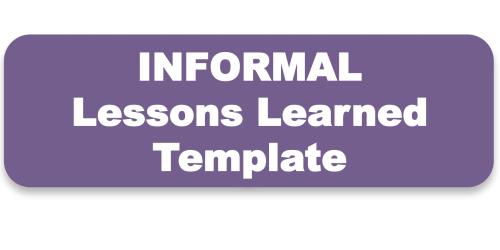Here is a Toolkit for Conducting Lessons Learned:
The purpose of conducting lessons learned is to capture the knowledge learned during the course of business, or while implementing projects. The goal is to encourage the recurrence of positive outcomes while deterring undesirable ones. In order to do it well you must:
-
Identify best practices and lessons learned.
-
Document these lessons.
-
Archive lessons learned to save for future reference and for others to access.
-
Disseminate lessons learned to appropriate & interested parties.
-
Form a list of actions to be taken based on lessons learned.
-
Follow up to monitor that the appropriate actions have taken place.
The objective is to prepare your team & future individuals with information that can better set them up for success. By building on past experiences, everyone will be more efficient and effective. Successful Managers use the lessons learned process as a management tool. From Marketing to Operations, Project Management to IT, Customer Service to Quality & Safety, this process is a powerful way to foster creativity, share ideas and make significant improvements.
Lessons Learned Templates & Guide - Two FREE Downloads


Why Is This Important To You?
It happens to all of us. Our organization, employees or project teams make mistakes and change course, table good ideas for a “later” date, or receive unsolicited & undocumented feedback from customers. Unfortunately, we forget to address these lessons as actionable opportunities on how TO DO or how NOT TO DO whatever it is that we learned. Instead of capturing and maintain this knowledge, we put it on the back burner assuming we will get to it later, or that we will remember to incorporate it into future activities. As a leader or manager, this lack of timely action is a disservice to your team and to your company. You have an opportunity to make improvements everyday, but if you don’t formalize the process by using Lessons Learned Templates to implement and communicate them, you are missing your opportunity to lead.
Great Managers are proactive when it comes to lessons learned. They see it as a means to improve productivity, increase efficiency and create a culture of innovation and continuous improvement. Conducting lessons learned should be part of your management routine because it allows you to continuously train your organization to be more productive, better focused and more profitable.
Sharing lessons from our accomplishments, and learning from our mistakes seems like a no brainer, but without a formal process, it just doesn't happen. Instead, redundancy occurs, mistakes happen over and over…maybe not by the same person, but by a different person each time. Case in point. I spent a good part of my career fixing broken businesses. When things aren’t working, there is turnover, where there is turnover, there is lost information. I’ve worked with companies that support multiple ERP systems and don’t even realize it, and manufacture different specifications for the same product not knowing why. These may seem like dramatic examples, but they are real and there is a high likelihood that inefficiencies & errors are happening around you without you knowing it. It can be as simple as reports being generated that nobody looks at, or key metrics that don’t drive your organization. Conducting lessons learned is a great way to lead positive improvements in your team and in your company. So let’s get started formalizing the process for your organization.
There are two forms of conducting lessons learned: Formal & Informal
Formal Lessons Learned
A Formal Lessons Learned Process is a meeting that takes place at the end of a project/activity OR at the end of each phase of the project/activity.
Summarize the Overall Project:
Answer the Following Questions:
-
What can we do to improve AND What worked well in these areas…
-
Project Management
-
Budgeting
-
Communication
-
Procurement
-
Time Management, Scheduling
-
Management of Financial and Human Resources
-
Management of External Contractors & Services
-
What were are our strengths AND weaknesses in the following areas:
-
Receiving and incorporating feedback from customers.
-
Requesting & receiving support from project sponsors/management.
-
Flexibility/Agility of project scope.
-
Identifying and Mitigating Risks
Set Expectations for Moving Forward:
-
Prioritize Recommendations to Improve.
-
Assign Accountability and Time Targets for Implementing Improvements
-
Establish a Formal Meeting Schedule to Review Progress
-
Create a Communications Plan to Share Results & Best Practice
Five Recommendations for Conducting a FORMAL Lessons Learned Process:
-
Utilize a survey of all team members, managers, sponsors, customers & support staff to collect as much information as possible prior to the lessons learned meeting. Report your findings at the meeting as you start each discussion topic and add on with meeting dialog.
-
Don’t attempt to implement every improvement by the next meeting. Have the team vote on the top 4-5 opportunities and focus there. You can choose to implement other improvements once those are completed.
-
Every new process should result in the elimination of something old. Your objective is not to increase workload; it is to make it more streamlined & effective.
-
You can capture lessons learned ideas at any time throughout the project if you have a means to do so. Start the dialog at the beginning of the project so the thought of continuous improvement is on the mind of all members, along with a system to capture and document feedback.
-
You may want to consider a lessons learned facilitator for this review. Someone who is impartial and can create a free-speaking environment.
Informal Lessons Learned
An Informal Lessons Learned Process is a mechanism for capturing “Suggestion Box” improvements in line with business objectives.
Great ideas are often lost during team meetings, or they are never brought up due to time constraints. By having a formal process for the ideas from your team (at all levels), you can create a culture of continuous improvement and take real action to make improvements.
Establish Continuous Improvement Departmental and Business Goals as a Formal Document. We want to…(as an example)
-
Establish ways to improve the level of communication with customers.
-
Reduce Scrap
-
Eliminate Redundancy of Efforts
-
Improve Internal or Cross-Functional Communication
Create a document/form that employees can fill in with their ideas. Make sure it includes the following qualifying criteria:
-
Department of origin and others affected by the idea.
-
Department/Business Goal the idea addresses.
-
Is the idea something ongoing & repeatable by others?
-
What activity will be eliminated, streamlined by the new idea?
-
Who should lead the effort?
-
Describe the current situation/activity and the reason why it should be improved.
-
Establish a clearinghouse and facilitator for new ideas submitted.
-
Each idea should go to the Department Manager to facilitate a review.
-
Ideas should be discussed, voted on & prioritized during team meetings.
-
Assign Accountability and Time Targets for Implementing Improvements.
-
Establish a Formal Meeting Schedule to Review Progress.
-
Create a Communications Plan to Share Results & Best Practice.
Four Recommendations for Conducting an INFORMAL Lessons Leaned Process:
-
Managers should embrace the process as a management and leadership tool. It is a great teambuilding tactic to create an environment that promotes new ideas, celebrates achievements and acknowledges necessary improvements.
-
Don’t be overwhelmed by the process. Incorporate the prioritization processes into bi-monthly meetings, and an update from assigned parties during regular team meetings.
-
Communicate successes throughout your organization as part of your management report in a “Continuous Improvement” section of the report. Be sure to state the improvement, the activity that was eliminated and the benefit to the organization.
-
Don’t forget to copy your team/employees on the report. It is important that they see you are giving credit for their efforts.
It takes time to get your team comfortable with a lessons learned process. It depends on the initiative of your team, complexity of activities, and culture within the overall organization. But most importantly it depends on a Manager’s commitment to continuous improvement, teamwork and an innovative approach to leadership.
Managers don’t conduct lessons learned enough. Company wide programs often get started but fail because they are too big and not embraced or followed through. If you lead your own effort to incorporate these tools into your management routine, your results will improve…it’s that simple.
Finally, I want you to imagine something… When you have a question about how TO DO or how NOT TO DO something, you tend to go to your computer and use a search engine to see what you can learn from others out there in the world, right? Wouldn't it be amazing to create a virtual search engine for your team that has specific answers on company issues, processes and the ins and outs of your business?